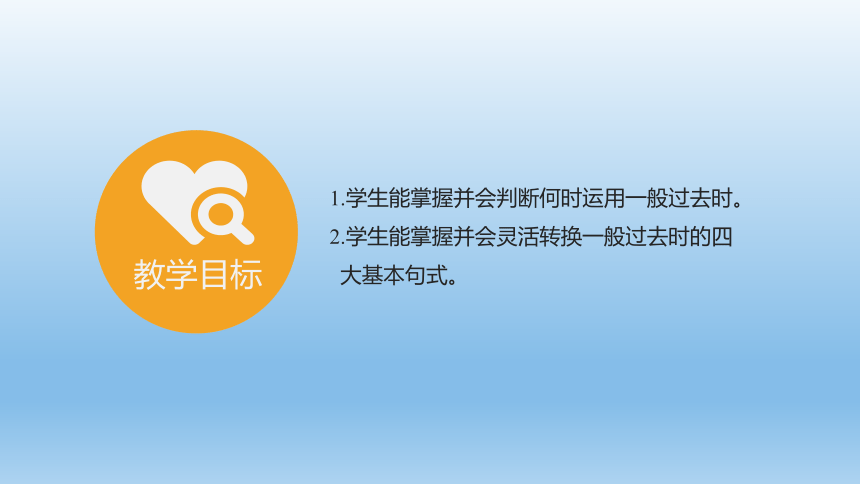Unit 2 It's Show Time! 一般过去时(课件48张)
文档属性
| 名称 | Unit 2 It's Show Time! 一般过去时(课件48张) |  | |
| 格式 | pptx | ||
| 文件大小 | 28.7MB | ||
| 资源类型 | 教案 | ||
| 版本资源 | 冀教版 | ||
| 科目 | 英语 | ||
| 更新时间 | 2022-03-10 20:28:48 | ||
图片预览












文档简介
(共48张PPT)
语法突破之
一般过去时(1)
程序框图
教学目标
1.学生能掌握并会判断何时运用一般过去时。
2.学生能掌握并会灵活转换一般过去时的四
大基本句式。
重难点
教学重点:一般过去时的概念及构成。
教学难点:灵活运用一般过去时基本
句式并会相互转换。
Steven:Hey,Peter.Look at this photo.You were at the pavilion.
Did you do anything interesting there
Peter: Yes,I did.I fed the monkeys with bananas.
And they ate happily.What about you
Steven: I enjoyed taking photos of all kinds of animals!
But I fell off when I took photos of the animals.
Peter: You’d better be careful next time!
一般过去时表示过去某个时间发生的动作或存在的状态 ,也可表示过去经常反复发生的动作。
定义
使用说明:请点击图片,触发动画,不要点击屏幕!
NO.1
表示过去某个时间发生的动作或存在的状态
例如: 我昨天7点起床。
I got up at 7:00 .
NO.2
表示过去经常反复发生的动作
(常与often,sometimes等频度副词连用)
去年他总是走路去上班。
He always walked to work last year.
NO.3
表示已故的人所做的事情
李白创作了许多杰作。
LiBai created a lot of great masterpieces.
NO.4
句子虽无明确时间状语,
但表达意思是过去发生的事。
你告诉过我你的名字,但现在我记不住了。
You told me your name ,but I can’t remember now.
其次,一般过去时的时间范畴很明确就是过去时间,而这也往往通过时间状语来体现。
1.表示时间词汇常与ago、last、yesterday等连用构成过去时间状语
2.其他时间状语
(刚 才) a moment
(三 小 时 前) three hours
(一 周 之 前) one week
(十个月之前) ten months
ago
morning (昨天早上)
yesterday afternoon(昨天下午)
evening (昨天晚上)
the day before yesterday 前天
night (昨晚)
Monday (上周一)
week (上周)
term (上学期)
time (上次)
last
just now (刚才)
in 2000 (在2000年)
before 6:00 (六点之前)
once upon a time (从前)
in the past (过去)
at the age of 5 (在5岁的时候)
将来时间
过去时间
NOW
现在
时间轴
(1)People built the ancient tower a long time ago.
(一般过去时)
(2)I usually go to school at 7:00 .
(一般现在时)
(3)Marco Polo went to China when he was 17.
(一般过去时)
小试牛刀/A profound
(1)People built the ancient tower a long time ago.
(一般过去时)
(2)I usually go to school at 7:00 .
(一般现在时)
(3)Marco Polo went to China when he was 17.
(一般过去时)
小试牛刀/A profound
(1)People built the ancient tower a long time ago.
(一般过去时)
(2)I usually go to school at 7:00 .
(一般现在时)
(3)Marco Polo went to China when he was 17.
(一般过去时)
小试牛刀/A profound
(1)People built the ancient tower a long time ago.
(一般过去时)
(2)I usually go to school at 7:00 .
(一般现在时)
(3)Marco Polo went to China when he was 17.
(一般过去时)
小试牛刀/A profound
(1)People built the ancient tower a long time ago.
(一般过去时)
(2)I usually go to school at 7:00 .
(一般现在时)
(3)Marco Polo went to China when he was 17.
(一般过去时)
小试牛刀/A profound
(1)People built the ancient tower a long time ago.
(一般过去时)
(2)I usually go to school at 7:00 .
(一般现在时)
(3)Marco Polo went to China when he was 17.
(一般过去时)
小试牛刀/A profound
(1)People built the ancient tower a long time ago.
(一般过去时)
(2)I usually go to school at 7:00 O’clock.
(一般现在时)
(3)Marco Polo went to China when he was 17.
(一般过去时)
一般过去时的句子结构
(1)People built the ancient tower a long time ago.
(一般过去时)
(2)I usually go to school at 7:00 O’clock.
(一般现在时)
(3)Marco Polo went to China when he was 17.
(一般过去时)
一般过去时的句子结构
主语
谓语
动词过去式
其他
be动词 情态动词 实义动词
动词过去式 was(am/is);were(are) could(can);might(may);should(shall常用于第一人);would(will用于所有人称) 规则动词过去式;
不规则动词过去式
肯定句 主语+was/were+其他 主语+情态动词过去式+动原+其他 主语+动词过去式+其他
否定句 主语+was/were+not+其他 (缩写wasn’t weren’t) 主语+情态动词过去式+not+动原+其他 (情态动词过去式缩略词couldn’t;mightn’t;shouldn’t;wouldn’t) 主语+didn’t+动原+其他
一般疑问句 Was/Were+主语+其他 肯定回答: Yes,主语人称代词+was/were. 否定回答: No,主语人称代词+wasn’t/weren’t. 情态动词过去式+主语+动原+其他 肯定回答: Yes,主语人称代词+情态动词过去式. 否定回答: No,主语人称代词+情态动词过去式否定缩略词. Did+主语+动原+其他
肯定回答:Yes,主语人称代词+did.
否定回答:No,主语人称代词+didn’t.
特殊疑问句 特殊疑问词(what,when,how……)+一般疑问句
四大基本句型
基本句型
谓语动词
句子一般过去时,表示过去发生事。
肯定句主谓宾,第一动词变过去。
否定句要记牢, didn’t放在动原前;
若有情态与be词,直接变为否定词。
疑问句有方法,did放在主语前;
注意一点别忘记,后面动词用动原;
若有情态与be词,直接提前放句首;
所有转换要注意,一二人称要互换。
知识小结/Summary
句子一般过去时,表示过去发生事。
肯定句主谓宾,第一动词变过去。
否定句要记牢, didn’t放在动原前;
若有情态与be词,直接变为否定词。
疑问句有方法,did放在主语前;
注意一点别忘记,后面动词用动原;
若有情态与be词,直接提前放句首;
所有转换要注意,一二人称要互换。
知识小结/Summary
句子一般过去时,表示过去发生事。
肯定句主谓宾,第一动词变过去。
否定句要记牢, didn’t放在动原前;
若有情态与be词,直接变为否定词。
疑问句有方法,did放在主语前;
注意一点别忘记,后面动词用动原;
若有情态与be词,直接提前放句首;
所有转换要注意,一二人称要互换。
知识小结/Summary
句子一般过去时,表示过去发生事。
肯定句主谓宾,第一动词变过去。
否定句要记牢, didn’t放在动原前;
若有情态与be词,直接变为否定词。
疑问句有方法,did放在主语前;
注意一点别忘记,后面动词用动原;
若有情态与be词,直接提前放句首;
所有转换要注意,一二人称要互换。
知识小结/Summary
句子一般过去时,表示过去发生事。
肯定句主谓宾,第一动词变过去。
否定句要记牢, didn’t放在动原前;
若有情态与be词,直接变为否定词。
疑问句有方法,did放在主语前;
注意一点别忘记,后面动词用动原;
若有情态与be词,直接提前放句首;
所有转换要注意,一二人称要互换。
知识小结/Summary
句子一般过去时,表示过去发生事。
肯定句主谓宾,第一动词变过去。
否定句要记牢, didn’t放在动原前;
若有情态与be词,直接变为否定词。
疑问句有方法,did放在主语前;
注意一点别忘记,后面动词用动原;
若有情态与be词,直接提前放句首;
所有转换要注意,一二人称要互换。
知识小结/Summary
句子一般过去时,表示过去发生事。
肯定句主谓宾,第一动词变过去。
否定句要记牢, didn’t放在动原前;
若有情态与be词,直接变为否定词。
疑问句有方法,did放在主语前;
注意一点别忘记,后面动词用动原;
若有情态与be词,直接提前放句首;
所有转换要注意,一二人称要互换。
知识小结/Summary
句子一般过去时,表示过去发生事。
肯定句主谓宾,第一动词变过去。
否定句要记牢, didn’t放在动原前;
若有情态与be词,直接变为否定词。
疑问句有方法,did放在主语前;
注意一点别忘记,后面动词用动原;
若有情态与be词,直接提前放句首;
所有转换要注意,一二人称要互换。
知识小结/Summary
句子一般过去时,表示过去发生事。
肯定句主谓宾,第一动词变过去。
否定句要记牢, didn’t放在动原前;
若有情态与be词,直接变为否定词。
疑问句有方法,did放在主语前;
注意一点别忘记,后面动词用动原;
若有情态与be词,直接提前放句首;
所有转换要注意,一二人称要互换。
知识小结/Summary
句子一般过去时,表示过去发生事。
肯定句主谓宾,第一动词变过去。
否定句要记牢, didn’t放在动原前;
若有情态与be词,直接变为否定词。
疑问句有方法,did放在主语前;
注意一点别忘记,后面动词用动原;
若有情态与be词,直接提前放句首;
所有转换要注意,一二人称要互换。
知识小结/Summary
一展身手/ McCoy:
(1) There was a car in front of the house just now.
否定句: There was a car in front of the house just now.
一般疑问句: there Was a car in front of the house
肯定回答: Yes,there was.
否定回答: No,there wasn’t.
(2)They played football on the playground.
否定句: They didn’t play football on the playground.
一般疑问句: Did they play football on the playground.
肯定回答: Yes,they did.
否定回答: No,they didn’t.
一展身手/ McCoy:
(1) There was a car in front of the house just now.
否定句:There was a car in front of the house just now.
一般疑问句: there Was a car in front of the house
肯定回答: Yes,there was.
否定回答: No,there wasn’t.
(2)They played football on the playground.
否定句: They didn’t play football on the playground.
一般疑问句: Did they play football on the playground.
肯定回答: Yes,they did.
否定回答: No,they didn’t.
一展身手/ McCoy:
(1) There was a car in front of the house just now.
否定句:There was not a car in front of the house just now..
一般疑问句: there Was a car in front of the house just now
肯定回答: Yes,there was.
否定回答: No,there wasn’t.
(2)They played football on the playground.
否定句: They didn’t play football on the playground.
一般疑问句: Did they play football on the playground.
肯定回答: Yes,they did.
否定回答: No,they didn’t.
一展身手/ McCoy:
(1) There was a car in front of the house just now.
否定句:There was not a car in front of the house just now.
一般疑问句: Was there a car in front of the house just now
肯定回答: Yes,there was.
否定回答: No,there wasn’t.
(2)They played football on the playground.
否定句: They didn’t play football on the playground.
一般疑问句: Did they play football on the playground.
肯定回答: Yes,they did.
否定回答: No,they didn’t.
一展身手/ McCoy:
(1) There was a car in front of the house just now.
否定句:There was not a car in front of the house just now.
一般疑问句: Was there a car in front of the house just now
肯定回答: Yes,there was.
否定回答: No,there wasn’t.
(2)They played football on the playground.
否定句: They didn’t play football on the playground.
一般疑问句: Did they play football on the playground.
肯定回答: Yes,they did.
否定回答: No,they didn’t.
一展身手/ McCoy:
(1) There was a car in front of the house just now.
否定句:There was not a car in front of the house just now.
一般疑问句: Was there a car in front of the house just now
肯定回答: Yes,there was.
否定回答: No,there wasn’t.
(2)They played football on the playground.
否定句: They didn’t play football on the playground.
一般疑问句: Did they play football on the playground.
肯定回答: Yes,they did.
否定回答: No,they didn’t.
一展身手/ McCoy:
(1) There was a car in front of the house just now.
否定句:There was not a car in front of the house just now.
一般疑问句: Was there a car in front of the house just now
肯定回答: Yes,there was.
否定回答: No,there wasn’t.
(2)They played football on the playground.
否定句: They didn’t play football on the playground.
一般疑问句: Did they play football on the playground.
肯定回答: Yes,they did.
否定回答: No,they didn’t.
小妙招
一定时态为过去;
二找情态与be词;
三按规则把句变;
四把人称动词查。
一展身手/ McCoy:
(1) There was a car in front of the house just now.
否定句:There was not a car in front of the house just now.
一般疑问句: Was there a car in front of the house just now
肯定回答: Yes,there was.
否定回答: No,there wasn’t.
(2)They played football on the playground.
否定句: They play football on the playground.
一般疑问句: Did they play football on the playground.
肯定回答: Yes,they did.
否定回答: No,they didn’t.
一展身手/ McCoy:
1) There was a car in front of the house just now.
否定句:There was not a car in front of the house just now.
一般疑问句: Was there a car in front of the house just now
肯定回答: Yes,there was.
否定回答: No,there wasn’t.
(2)They played football on the playground.
否定句: They didn’t play football on the playground..
一般疑问句: they played football on the playground.
肯定回答: Yes,they did.
否定回答: No,they didn’t.
一展身手/ McCoy:
1) There was a car in front of the house just now.
否定句:There was not a car in front of the house just now.
一般疑问句: Was there a car in front of the house just now
肯定回答: Yes,there was.
否定回答: No,there wasn’t.
(2)They played football on the playground.
否定句: They didn’t play football on the playground..
一般疑问句: Did they play football on the playground
肯定回答: Yes,they did.
否定回答: No,they didn’t.
一展身手/ McCoy:
1) There was a car in front of the house just now.
否定句:There was not a car in front of the house just now.
一般疑问句: Was there a car in front of the house just now
肯定回答: Yes,there was.
否定回答: No,there wasn’t.
(2)They played football on the playground.
否定句: They didn’t play football on the playground..
一般疑问句: Did they play football on the playground
肯定回答: Yes,they did.
否定回答: No,they didn’t.
一展身手/ McCoy:
1) There was a car in front of the house just now.
否定句:There was not a car in front of the house just now.
一般疑问句: Was there a car in front of the house just now
肯定回答: Yes,there was.
否定回答: No,there wasn’t.
(2)They played football on the playground.
否定句: They didn’t play football on the playground.
一般疑问句: Did they play football on the playground.
肯定回答: Yes,they did.
否定回答: No,they didn’t.
本节我们讲授了一般过去时用法以及句子基本构成。
同时我们根据句子中所包含的动词过去式总结了对应的四大基本句式以及相应的句型转换小妙招,相信同学对一般过去时已经有了一定的认识。
小结
再见 /Goodbye
语法突破之
一般过去时(1)
程序框图
教学目标
1.学生能掌握并会判断何时运用一般过去时。
2.学生能掌握并会灵活转换一般过去时的四
大基本句式。
重难点
教学重点:一般过去时的概念及构成。
教学难点:灵活运用一般过去时基本
句式并会相互转换。
Steven:Hey,Peter.Look at this photo.You were at the pavilion.
Did you do anything interesting there
Peter: Yes,I did.I fed the monkeys with bananas.
And they ate happily.What about you
Steven: I enjoyed taking photos of all kinds of animals!
But I fell off when I took photos of the animals.
Peter: You’d better be careful next time!
一般过去时表示过去某个时间发生的动作或存在的状态 ,也可表示过去经常反复发生的动作。
定义
使用说明:请点击图片,触发动画,不要点击屏幕!
NO.1
表示过去某个时间发生的动作或存在的状态
例如: 我昨天7点起床。
I got up at 7:00 .
NO.2
表示过去经常反复发生的动作
(常与often,sometimes等频度副词连用)
去年他总是走路去上班。
He always walked to work last year.
NO.3
表示已故的人所做的事情
李白创作了许多杰作。
LiBai created a lot of great masterpieces.
NO.4
句子虽无明确时间状语,
但表达意思是过去发生的事。
你告诉过我你的名字,但现在我记不住了。
You told me your name ,but I can’t remember now.
其次,一般过去时的时间范畴很明确就是过去时间,而这也往往通过时间状语来体现。
1.表示时间词汇常与ago、last、yesterday等连用构成过去时间状语
2.其他时间状语
(刚 才) a moment
(三 小 时 前) three hours
(一 周 之 前) one week
(十个月之前) ten months
ago
morning (昨天早上)
yesterday afternoon(昨天下午)
evening (昨天晚上)
the day before yesterday 前天
night (昨晚)
Monday (上周一)
week (上周)
term (上学期)
time (上次)
last
just now (刚才)
in 2000 (在2000年)
before 6:00 (六点之前)
once upon a time (从前)
in the past (过去)
at the age of 5 (在5岁的时候)
将来时间
过去时间
NOW
现在
时间轴
(1)People built the ancient tower a long time ago.
(一般过去时)
(2)I usually go to school at 7:00 .
(一般现在时)
(3)Marco Polo went to China when he was 17.
(一般过去时)
小试牛刀/A profound
(1)People built the ancient tower a long time ago.
(一般过去时)
(2)I usually go to school at 7:00 .
(一般现在时)
(3)Marco Polo went to China when he was 17.
(一般过去时)
小试牛刀/A profound
(1)People built the ancient tower a long time ago.
(一般过去时)
(2)I usually go to school at 7:00 .
(一般现在时)
(3)Marco Polo went to China when he was 17.
(一般过去时)
小试牛刀/A profound
(1)People built the ancient tower a long time ago.
(一般过去时)
(2)I usually go to school at 7:00 .
(一般现在时)
(3)Marco Polo went to China when he was 17.
(一般过去时)
小试牛刀/A profound
(1)People built the ancient tower a long time ago.
(一般过去时)
(2)I usually go to school at 7:00 .
(一般现在时)
(3)Marco Polo went to China when he was 17.
(一般过去时)
小试牛刀/A profound
(1)People built the ancient tower a long time ago.
(一般过去时)
(2)I usually go to school at 7:00 .
(一般现在时)
(3)Marco Polo went to China when he was 17.
(一般过去时)
小试牛刀/A profound
(1)People built the ancient tower a long time ago.
(一般过去时)
(2)I usually go to school at 7:00 O’clock.
(一般现在时)
(3)Marco Polo went to China when he was 17.
(一般过去时)
一般过去时的句子结构
(1)People built the ancient tower a long time ago.
(一般过去时)
(2)I usually go to school at 7:00 O’clock.
(一般现在时)
(3)Marco Polo went to China when he was 17.
(一般过去时)
一般过去时的句子结构
主语
谓语
动词过去式
其他
be动词 情态动词 实义动词
动词过去式 was(am/is);were(are) could(can);might(may);should(shall常用于第一人);would(will用于所有人称) 规则动词过去式;
不规则动词过去式
肯定句 主语+was/were+其他 主语+情态动词过去式+动原+其他 主语+动词过去式+其他
否定句 主语+was/were+not+其他 (缩写wasn’t weren’t) 主语+情态动词过去式+not+动原+其他 (情态动词过去式缩略词couldn’t;mightn’t;shouldn’t;wouldn’t) 主语+didn’t+动原+其他
一般疑问句 Was/Were+主语+其他 肯定回答: Yes,主语人称代词+was/were. 否定回答: No,主语人称代词+wasn’t/weren’t. 情态动词过去式+主语+动原+其他 肯定回答: Yes,主语人称代词+情态动词过去式. 否定回答: No,主语人称代词+情态动词过去式否定缩略词. Did+主语+动原+其他
肯定回答:Yes,主语人称代词+did.
否定回答:No,主语人称代词+didn’t.
特殊疑问句 特殊疑问词(what,when,how……)+一般疑问句
四大基本句型
基本句型
谓语动词
句子一般过去时,表示过去发生事。
肯定句主谓宾,第一动词变过去。
否定句要记牢, didn’t放在动原前;
若有情态与be词,直接变为否定词。
疑问句有方法,did放在主语前;
注意一点别忘记,后面动词用动原;
若有情态与be词,直接提前放句首;
所有转换要注意,一二人称要互换。
知识小结/Summary
句子一般过去时,表示过去发生事。
肯定句主谓宾,第一动词变过去。
否定句要记牢, didn’t放在动原前;
若有情态与be词,直接变为否定词。
疑问句有方法,did放在主语前;
注意一点别忘记,后面动词用动原;
若有情态与be词,直接提前放句首;
所有转换要注意,一二人称要互换。
知识小结/Summary
句子一般过去时,表示过去发生事。
肯定句主谓宾,第一动词变过去。
否定句要记牢, didn’t放在动原前;
若有情态与be词,直接变为否定词。
疑问句有方法,did放在主语前;
注意一点别忘记,后面动词用动原;
若有情态与be词,直接提前放句首;
所有转换要注意,一二人称要互换。
知识小结/Summary
句子一般过去时,表示过去发生事。
肯定句主谓宾,第一动词变过去。
否定句要记牢, didn’t放在动原前;
若有情态与be词,直接变为否定词。
疑问句有方法,did放在主语前;
注意一点别忘记,后面动词用动原;
若有情态与be词,直接提前放句首;
所有转换要注意,一二人称要互换。
知识小结/Summary
句子一般过去时,表示过去发生事。
肯定句主谓宾,第一动词变过去。
否定句要记牢, didn’t放在动原前;
若有情态与be词,直接变为否定词。
疑问句有方法,did放在主语前;
注意一点别忘记,后面动词用动原;
若有情态与be词,直接提前放句首;
所有转换要注意,一二人称要互换。
知识小结/Summary
句子一般过去时,表示过去发生事。
肯定句主谓宾,第一动词变过去。
否定句要记牢, didn’t放在动原前;
若有情态与be词,直接变为否定词。
疑问句有方法,did放在主语前;
注意一点别忘记,后面动词用动原;
若有情态与be词,直接提前放句首;
所有转换要注意,一二人称要互换。
知识小结/Summary
句子一般过去时,表示过去发生事。
肯定句主谓宾,第一动词变过去。
否定句要记牢, didn’t放在动原前;
若有情态与be词,直接变为否定词。
疑问句有方法,did放在主语前;
注意一点别忘记,后面动词用动原;
若有情态与be词,直接提前放句首;
所有转换要注意,一二人称要互换。
知识小结/Summary
句子一般过去时,表示过去发生事。
肯定句主谓宾,第一动词变过去。
否定句要记牢, didn’t放在动原前;
若有情态与be词,直接变为否定词。
疑问句有方法,did放在主语前;
注意一点别忘记,后面动词用动原;
若有情态与be词,直接提前放句首;
所有转换要注意,一二人称要互换。
知识小结/Summary
句子一般过去时,表示过去发生事。
肯定句主谓宾,第一动词变过去。
否定句要记牢, didn’t放在动原前;
若有情态与be词,直接变为否定词。
疑问句有方法,did放在主语前;
注意一点别忘记,后面动词用动原;
若有情态与be词,直接提前放句首;
所有转换要注意,一二人称要互换。
知识小结/Summary
句子一般过去时,表示过去发生事。
肯定句主谓宾,第一动词变过去。
否定句要记牢, didn’t放在动原前;
若有情态与be词,直接变为否定词。
疑问句有方法,did放在主语前;
注意一点别忘记,后面动词用动原;
若有情态与be词,直接提前放句首;
所有转换要注意,一二人称要互换。
知识小结/Summary
一展身手/ McCoy:
(1) There was a car in front of the house just now.
否定句: There was a car in front of the house just now.
一般疑问句: there Was a car in front of the house
肯定回答: Yes,there was.
否定回答: No,there wasn’t.
(2)They played football on the playground.
否定句: They didn’t play football on the playground.
一般疑问句: Did they play football on the playground.
肯定回答: Yes,they did.
否定回答: No,they didn’t.
一展身手/ McCoy:
(1) There was a car in front of the house just now.
否定句:There was a car in front of the house just now.
一般疑问句: there Was a car in front of the house
肯定回答: Yes,there was.
否定回答: No,there wasn’t.
(2)They played football on the playground.
否定句: They didn’t play football on the playground.
一般疑问句: Did they play football on the playground.
肯定回答: Yes,they did.
否定回答: No,they didn’t.
一展身手/ McCoy:
(1) There was a car in front of the house just now.
否定句:There was not a car in front of the house just now..
一般疑问句: there Was a car in front of the house just now
肯定回答: Yes,there was.
否定回答: No,there wasn’t.
(2)They played football on the playground.
否定句: They didn’t play football on the playground.
一般疑问句: Did they play football on the playground.
肯定回答: Yes,they did.
否定回答: No,they didn’t.
一展身手/ McCoy:
(1) There was a car in front of the house just now.
否定句:There was not a car in front of the house just now.
一般疑问句: Was there a car in front of the house just now
肯定回答: Yes,there was.
否定回答: No,there wasn’t.
(2)They played football on the playground.
否定句: They didn’t play football on the playground.
一般疑问句: Did they play football on the playground.
肯定回答: Yes,they did.
否定回答: No,they didn’t.
一展身手/ McCoy:
(1) There was a car in front of the house just now.
否定句:There was not a car in front of the house just now.
一般疑问句: Was there a car in front of the house just now
肯定回答: Yes,there was.
否定回答: No,there wasn’t.
(2)They played football on the playground.
否定句: They didn’t play football on the playground.
一般疑问句: Did they play football on the playground.
肯定回答: Yes,they did.
否定回答: No,they didn’t.
一展身手/ McCoy:
(1) There was a car in front of the house just now.
否定句:There was not a car in front of the house just now.
一般疑问句: Was there a car in front of the house just now
肯定回答: Yes,there was.
否定回答: No,there wasn’t.
(2)They played football on the playground.
否定句: They didn’t play football on the playground.
一般疑问句: Did they play football on the playground.
肯定回答: Yes,they did.
否定回答: No,they didn’t.
一展身手/ McCoy:
(1) There was a car in front of the house just now.
否定句:There was not a car in front of the house just now.
一般疑问句: Was there a car in front of the house just now
肯定回答: Yes,there was.
否定回答: No,there wasn’t.
(2)They played football on the playground.
否定句: They didn’t play football on the playground.
一般疑问句: Did they play football on the playground.
肯定回答: Yes,they did.
否定回答: No,they didn’t.
小妙招
一定时态为过去;
二找情态与be词;
三按规则把句变;
四把人称动词查。
一展身手/ McCoy:
(1) There was a car in front of the house just now.
否定句:There was not a car in front of the house just now.
一般疑问句: Was there a car in front of the house just now
肯定回答: Yes,there was.
否定回答: No,there wasn’t.
(2)They played football on the playground.
否定句: They play football on the playground.
一般疑问句: Did they play football on the playground.
肯定回答: Yes,they did.
否定回答: No,they didn’t.
一展身手/ McCoy:
1) There was a car in front of the house just now.
否定句:There was not a car in front of the house just now.
一般疑问句: Was there a car in front of the house just now
肯定回答: Yes,there was.
否定回答: No,there wasn’t.
(2)They played football on the playground.
否定句: They didn’t play football on the playground..
一般疑问句: they played football on the playground.
肯定回答: Yes,they did.
否定回答: No,they didn’t.
一展身手/ McCoy:
1) There was a car in front of the house just now.
否定句:There was not a car in front of the house just now.
一般疑问句: Was there a car in front of the house just now
肯定回答: Yes,there was.
否定回答: No,there wasn’t.
(2)They played football on the playground.
否定句: They didn’t play football on the playground..
一般疑问句: Did they play football on the playground
肯定回答: Yes,they did.
否定回答: No,they didn’t.
一展身手/ McCoy:
1) There was a car in front of the house just now.
否定句:There was not a car in front of the house just now.
一般疑问句: Was there a car in front of the house just now
肯定回答: Yes,there was.
否定回答: No,there wasn’t.
(2)They played football on the playground.
否定句: They didn’t play football on the playground..
一般疑问句: Did they play football on the playground
肯定回答: Yes,they did.
否定回答: No,they didn’t.
一展身手/ McCoy:
1) There was a car in front of the house just now.
否定句:There was not a car in front of the house just now.
一般疑问句: Was there a car in front of the house just now
肯定回答: Yes,there was.
否定回答: No,there wasn’t.
(2)They played football on the playground.
否定句: They didn’t play football on the playground.
一般疑问句: Did they play football on the playground.
肯定回答: Yes,they did.
否定回答: No,they didn’t.
本节我们讲授了一般过去时用法以及句子基本构成。
同时我们根据句子中所包含的动词过去式总结了对应的四大基本句式以及相应的句型转换小妙招,相信同学对一般过去时已经有了一定的认识。
小结
再见 /Goodbye
同课章节目录
- Unit 1 A Trip to the Silk Road
- Lesson 1 A Trip to China
- Lesson 2 Meet You in Beijing
- Lesson 3 A Visit to Xi'an
- Lesson 4 A Visit to Lanzhou
- Lesson 5 Another Stop along the Silk Road
- Lesson 6 Jenny's Diary
- Unit 2 It's Show Time!
- Lesson 7 What's Your Project about?
- Lesson 8 Marco Polo and the Silk Road
- Lesson 9 Danny's School Project
- Lesson 10 Music and Dance
- Lesson 11 Food in China
- Lesson 12 A Blog about the Silk Road
- Unit 3 School Life
- Lesson 13 How Is School Going?
- Lesson 14 Jenny's School Life
- Lesson 15 Making a Difference
- Lesson 16 We Are with You!
- Lesson 17 School Science Fai
- Lesson 18 Teaching in China
- Unit 4 After-School Activities
- Lesson 19 A Dinner Date
- Lesson 20 Join Our Club!
- Lesson 21 What Is Your Club Type?
- Lesson 22 Big Plans for the Weekend
- Lesson 23 A Weekend with Grandma
- Lesson 24 How was Your Weekend?
- Unit 5 I Love Learning English!
- Lesson 25 A Phone Friend
- Lesson 26 Online Phone Calls
- Lesson 27 Amazing English
- Lesson 28 How Do I Learn English?
- Lesson 29 A Door to the World
- Lesson 30 Writing an E-mail in English
- Unit 6 Seasons
- Lesson 31 What Strange Weather!
- Lesson 32 I Can't Wait for Winter!
- Lesson 33 Kim's Favourite Season
- Lesson 34 Steven's Report
- Lesson 35 Surfing in Sydney
- Lesson 36 Spring in China
- Unit 7 Sports and Good Health
- Lesson 37 You Are What You Eat!
- Lesson 38 Stay Healthy!
- Lesson 39 Danny's Report
- Lesson 40 Move Your Body
- Lesson 41 Were People Healthy Then?
- Lesson 42 Know Yourself
- Unit 8 Summer Holiday Is Coming!
- Lesson 43 Have a Good Summer!
- Lesson 44 Volunteering in Summe
- Lesson 45 Baseball Season
- Lesson 46 Get Ready for Summer Holiday!
- Lesson 47 Summer Plans
- Lesson 48 Li Ming's Summer Holiday
